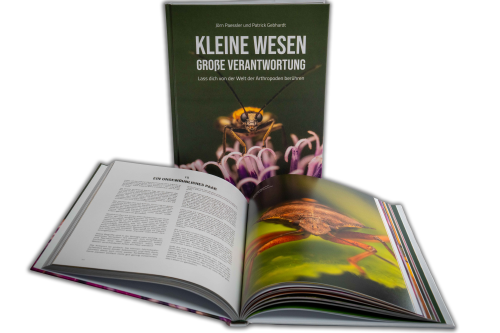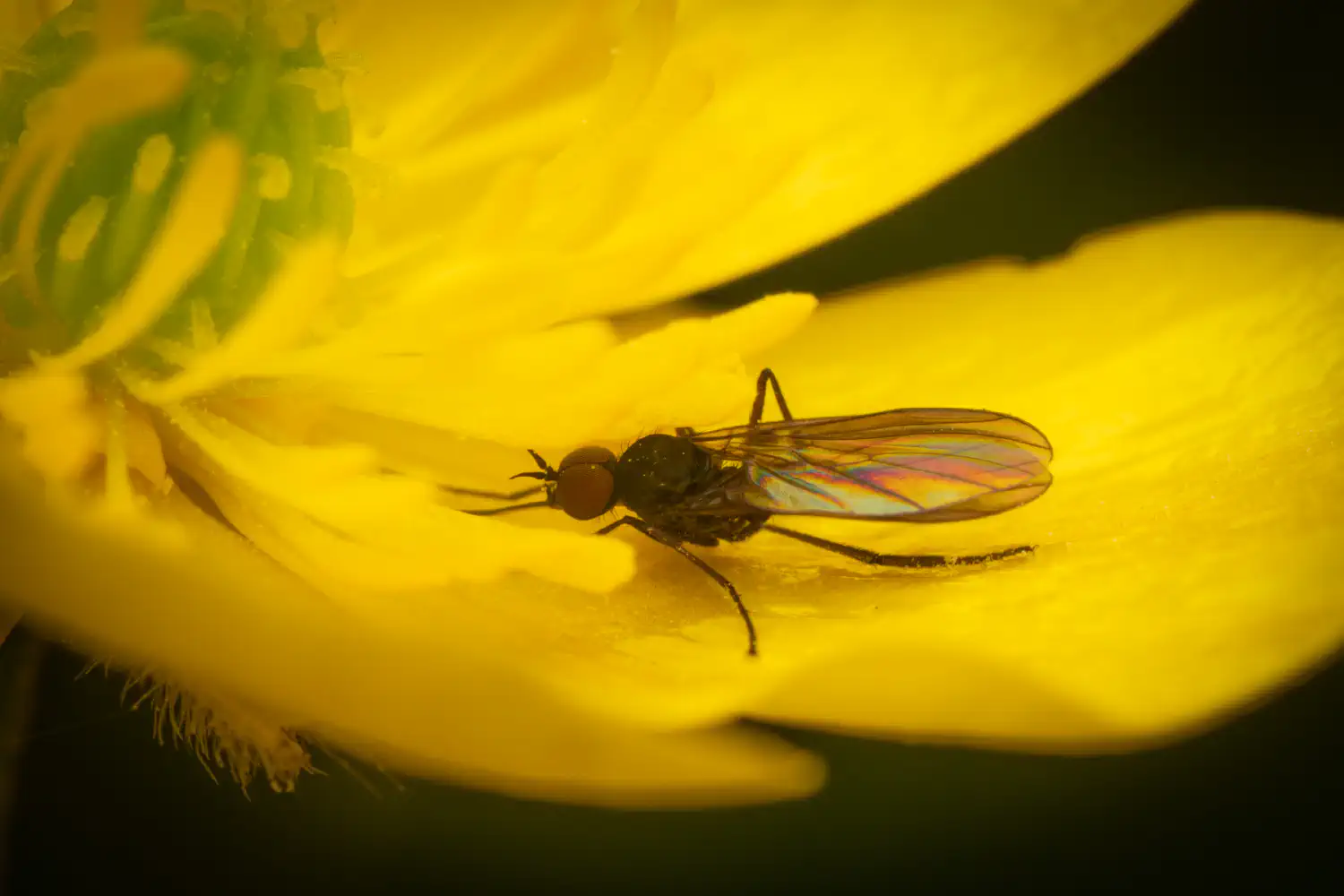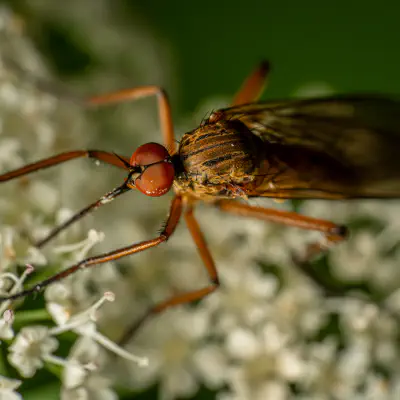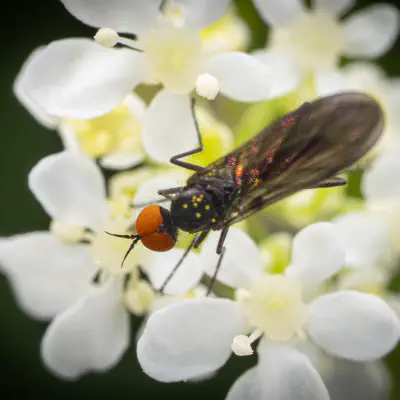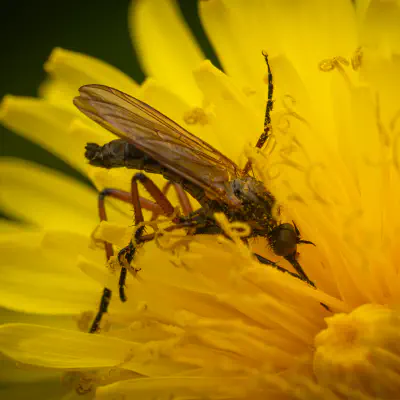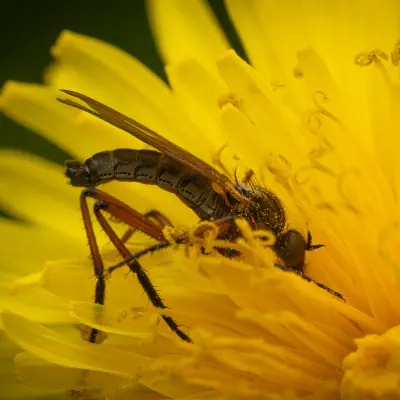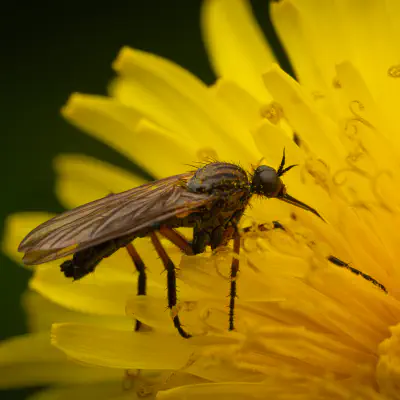Dance Flies Lat. “Empididae“
Empididae is a family of flies with over 3,000 described species occurring worldwide in all the Ecozones but the majority are found in the Holarctic. They are mainly predatory flies like most of their relatives in the Empidoidea, and exhibit a wide range of forms but are generally small to medium sized, non-metallic and rather bristly.
Hierarchy
Description
Empididae are small to medium-sized flies, rarely large (1.0 to 15.0 mm). The body is slender, or elongated and rarely thickset. The colour ranges from yellow to black, and they may be pollinose or lustrous, but never have a metallic gloss. The head is often small and rounded with relatively large eyes. The eyes of the male and (rarely) the female may be contiguous (holoptic). The antenna usually have three segments of which the third is the largest and bears a long or short, usually apical arista or style. The eyes often have an incision (notch) at the level of the antennae. The proboscis is often long and in several genera powerful and piercing. If the mouthparts are strongly elongate they project forward or downward toward the fore legs. Some species have short mouthparts. The legs are usually long and slender but often powerful and in some cases, the fore legs are raptorial, adapted to catching and holding prey. The wings are clear or partially tinged and, in some species, with a stigma spot, or with a distinct pattern. Radial vein R4+5 is often forked and the discal-medial cell (dm) is almost always present. The costa ends at or just beyond R4+5, or continues along the wing margin, and can be used as a characteristic to distinguish it from other families. The venation of the wings in minute species is often simplified. The posterior part of the wings on the basal side of the anal vein bears the designation of axillary or anal lobe. In species with a highly developed axillary lobe, the margin may form an angle with the margin of the alula. This is termed the axillary angle, the size of which is often a good diagnostic feature. It can be distinguished from Dolichopodidae and Hybotidae by the presence of unrotated and symmetrical terminalia. The point of origin of Rs (radial sector) is at a distance from the humeral crossvein (h) equal to or longer than the length of h. Except for a few species, Empididae is easily distinguishable from the families Ragadidae and Atelestidae by having a prosternum that is fused with the proepisternum, which forms a precoxal bridge. The larvae have a very slim and reduced head capsule (hemicephalic) which is often retracted into the thorax and an eight-segmented abdomen with paired prolegs, distally bearing hooks, on abdominal segments 1–7 or 1–8. The posterior spiracles are highly separated if present at all and the anal segment typically bears one to four lobes. The predaceous or detritus-consuming larvae feed using mouth hooks with constrained movement. The pupae do not have a puparium.
Biology
Adult empidids are found in a variety of forest habitats, on the leaves of plants, on tree trunks, aquatic vegetation and also in stream beds and seepage habitats. Some species are associated with open areas such as grasslands, agricultural fields, marshes, coastal zones and beaches. Adults capture arthropod prey, including other Diptera (including other empidids), Hemiptera, Homoptera, Lepidoptera, Trichoptera, Thysanoptera, Hymenoptera, Neuroptera, Plecoptera, Ephemeroptera, Coleoptera, Collembola, and Acari. Because of their predation they are important natural and biological control agents of various pest insect species and as a group with a vast species diversity they occupy a wide range of habitats. Some adult Empididae also visit flowers to obtain nectar. At least a few groups (Iteaphila, Anthepiscopus, Anthalia, Allanthalia and Euthyneura) obtain all their protein needs by feeding on pollen. Larvae are generally found in moist soil, rotten wood, dung, or in aquatic habitats and also appear to be predaceous on various arthropods, particularly other Diptera larvae. Some Empididae, such as the European species Hilara maura, have an elaborate courtship ritual in which the male wraps a prey item in silk and presents it to the female to stimulate copulation. It was first noticed that these flies carried “nuptial gifts” of silk by Baron Karl von Osten-Sacken. Empididae show diverse mating systems, ranging from species in which males aggregate in mating swarms, and compete for choosing females to sex-role reversed species in which females do aggregate and compete for the attention of choosing males. In some species, such as the North American species Rhamphomyia longicauda, competition for the food provided by males is so strong that females have developed elaborate ornaments, including feathery “pennate” scales on their legs, darkened wings, and inflatable abdominal sacs that enhance their attractiveness.
Evolution and systematics
Empididae are well represented in amber deposits and the family certainly seems to have been well established by the Cretaceous period at the latest. Two groups formerly placed here as subfamilies are now generally regarded as separate families in the Empidoidea: Atelestidae and Hybotidae. The Brachystomatidae are also sometimes separated as a distinct family, but this seems to be in error. The Microphorinae were long placed in the Empididae as a subfamily, then briefly classified as a distinct family, and are now considered a subfamily of the long-legged flies (Dolichopodidae).
Among the subfamilies currently placed herein, not all are confirmed to be monophyletic groups. Some rearrangements, in particular regarding the delimitation of Empididae versus Dolichopodidae – which together represent the bulk and the most advanced lineages of the Empidoidea – are likely to take place in the future. The Brachystomatinae, Empidinae and Hemerodromiinae however seem to be natural groups of closest relatives in their entirety, and the Clinocerinae apparently are for the largest part. Based on the most recent phylogenetic studies, the relationship between Empididae and other members of Empidoidea is as follows. The placement of Empididae is emphasized in bold formatting.
Genera
The subfamilies with their tribes and selected genera are: Empidinae Schiner, 1862
Tribe Empidini Clinorhampha Collin, 1933 Edenophorus Smith, 1969 Empidadelpha Collin, 1928 Empis Linnaeus, 1758 Hystrichonotus Collin, 1933 Lamprempis Wheeler & Melander, 1901 Macrostomus Wiedemann, 1817 Opeatocerata Melander, 1928 Porphyrochroa Melander, 1928 Rhamphella Malloch, 1930 Rhamphempis Daugeron, 2024 Rhamphomyia Meigen, 1822 Sphicosa Philippi, 1865 Tribe Hilarini Afroempis Smith, 1969 Allochrotus Collin, 1933 Amictoides Bezzi, 1909 Aplomera Macquart, 1838 Atrichopleura Bezzi, 1909 Bandella Bickel, 2002 Cunomyia Bickel, 1998 Deuteragonista Philippi, 1865 Gynatoma Collin, 1928 Hilara Meigen, 1822 Hilarempis Bezzi, 1905 Hilarigona Collin, 1933 Hybomyia Plant, 1995 Pasitrichotus Collin, 1933 Thinempis Bickel, 1996 Trichohilara Collin, 1933 Tribe Chelipodini Afrodromia Smith, 1969 Chelipoda Macquart, 1823 Chelipodozus Collin, 1933 Drymodromia Becker, 1914 Monodromia Collin, 1928 Phyllodromia Zetterstedt, 1837 Ptilophyllodromia Bezzi, 1904 Tribe Hemerodromiini Chelifera Macquart. 1823 Cladodromia Bezzi, 1933 Colabris Melander, 1928 Doliodromia Collin, 1928 Hemerodromia Meigen, 1822 Metachela Coquillett, 1903 Neoplasta Coquillett, 1895 Clinocerinae Collin, 1928
Aclinocera Yang & Yang, 1995 Afroclinocera Sinclair, 1999 Asymphyloptera Collin, 1933 Bergenstammia Mik, 1881 Clinocera Meigen, 1803 Clinocerella Engel, 1918 Dolichocephala Macquart, 1823 Hypenella Collin, 1941 Kowarzia Mik, 1881 Oreothalia Melander, 1902 Phaeobalia Mik, 1881 Proagomyia Collin, 1933 Proclinopyga Melander, 1928 Rhyacodromia Saigusa, 1986 Roederiodes Coquillett, 1901 Trichoclinocera Collin, 1941 Wiedemannia Zetterstedt, 1838 Brachystomatinae Melander, 1908 (Brachystomatidae was found to be nested within Empididae in Wahlberg & Johanson, 2018, and lowered to subfamily status, though some authors continue to treat the group as its own family within Empidoidea)
Tribe Brachystomatini Anomalempis Melander, 1928 Brachystoma Meigen, 1822 Xanthodromia Saigusa, 1986 Tribe Ceratomerini Ceratomerus Philippi, 1865 Glyphidopeza Sinclair, 1997 Zealandicesa Koçak & Kemal, 2010 Tribe Trichopezini Afropeza Sinclair & Shamshev, 2014 Rubistella Garrett Jones, 1940 Group Heleodromia Heleodromia Haliday, 1833 Pseudoheleodromia Wagner, 2001 Group Heterophlebus Apalocnemis Philippi, 1865 Gloma Meigen, 1822 Heterophlebus Philippi, 1865 Group Niphogenia Ceratempis Melander, 1927 Niphogenia Melander, 1928 Group Trichopeza Boreodromia Coquillett, 1903 Ephydrempis Saigusa, 1986 Sabroskyella Wilder, 1982 Trichopeza Rondani, 1856 Incertae sedis
Brochella Melander, 1927 Philetus Melander, 1928 Group Hesperempis Dryodromia Rondani, 1856 Hesperempis Melander, 1906 Toreus Melander, 1906
Identification
Chvála, M. (1994) The Empidoidea (Diptera) of Fennoscandia and Denmark. III. Genus Empis. Leiden: Brill 29. Collin, J.E. (1961) British Flies. VI. Empididae. Cambridge: Cambridge University Press. Engel, E. O., 1938-1954 Empididae. In: Lindner, E. (Ed.). Die Fliegen der Paläarktischen Region, 4, 28, 1-400. Frey, R. 1954- 1956 Empididae. In: Lindner, E. (Ed.). Die Fliegen der Paläarktischen Region 4, 28, 400-639. Gorodkov, K. B. and Kovalev V.G. Family Empididae in Bei-Bienko, G. Ya, 1988 Keys to the insects of the European Part of the USSR Volume 5 (Diptera) Part 2 English edition. Keys to Palaearctic species but now needs revision .
References
Chinery, Michael (1986): Collins Guide to the Insects of Britain and Western Europe. Moulton, J.K.; Wiegmann, B.M. (2007). “The phylogenetic relationships of flies in the superfamily Empidoidea (Insecta: Diptera)”. Mol. Phylogenet. Evol. 43 (3): 701–713. Bibcode:2007MolPE..43..701M. doi:10.1016/j.ympev.2007.02.029. PMID 17468014. Sinclair, B.J.; Cumming, J.M. (2006). “The morphology, higher-level phylogeny and classification of the Empidoidea (Diptera)” (PDF). Zootaxa. 1180: 1–172. doi:10.11646/zootaxa.1180.1.1. K. G. V. Smith, 1989 An introduction to the immature stages of British Flies. Diptera Larvae, with notes on eggs, puparia and pupae.Handbooks for the Identification of British Insects Vol 10 Part 14. pdf download manual (two parts Main text and figures index) Wahlberg, E.; Johanson, K.A. (2018). “Molecular phylogenetics reveals novel relationships within Empidoidea (Diptera)”. Systematic Entomology. 43 (4): 619–636. Bibcode:2018SysEn..43..619W. doi:10.1111/syen.12297.
External links
Data related to Empididae at Wikispecies Media related to Empididae at Wikimedia Commons Empididae In Italian Family Empididae at EOL images Diptera.info images NADS Family description Family description Fossil Diptera catalog Key to the British genera of Empididae
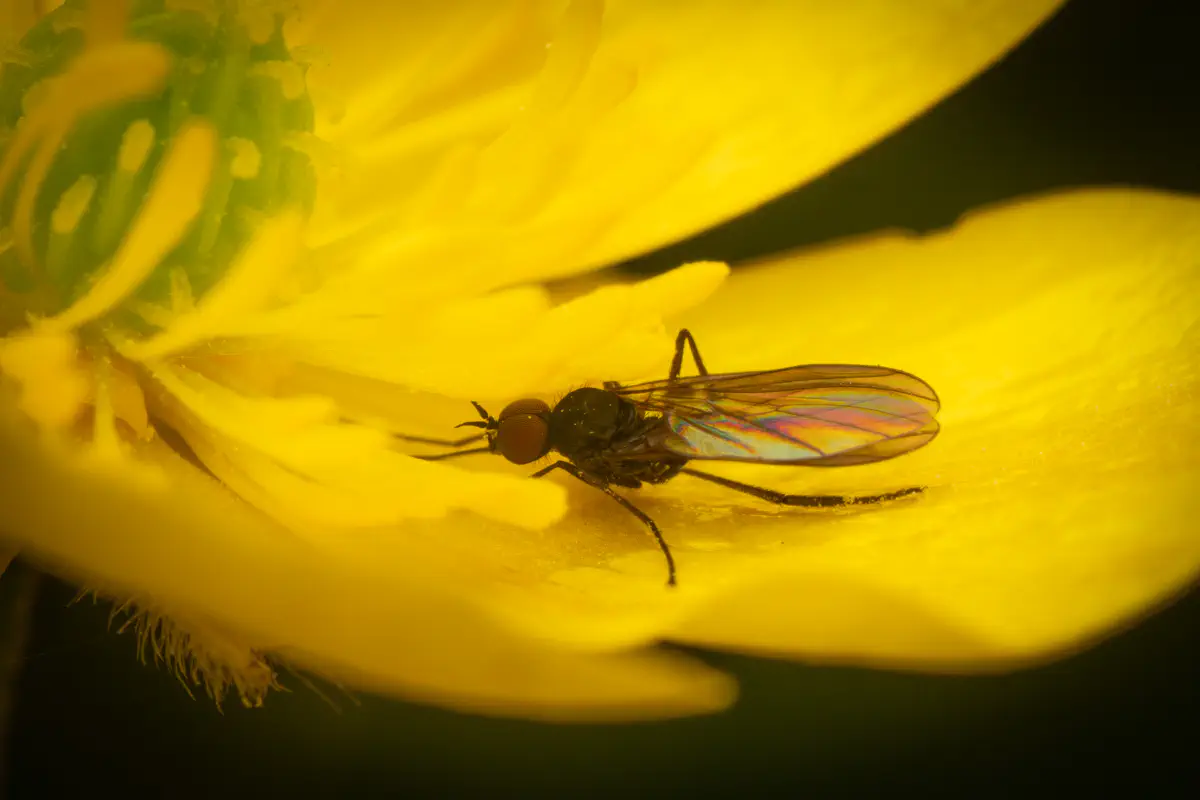
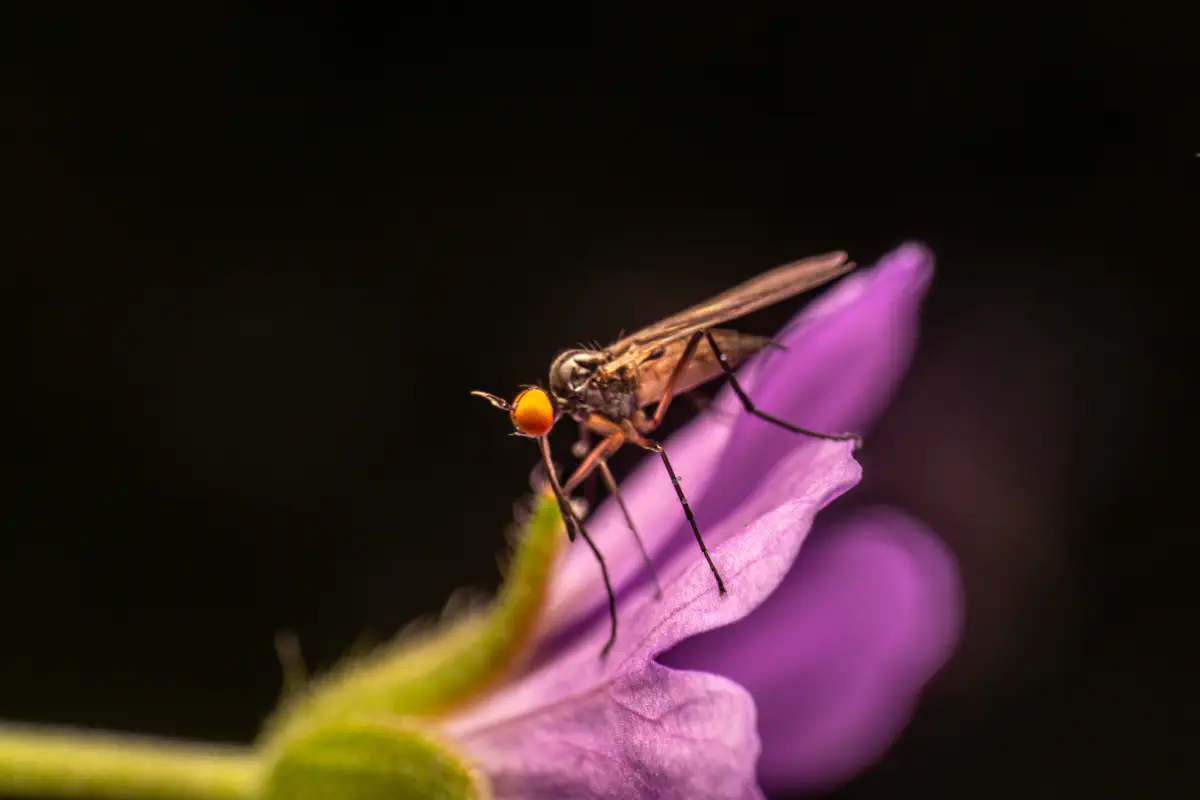
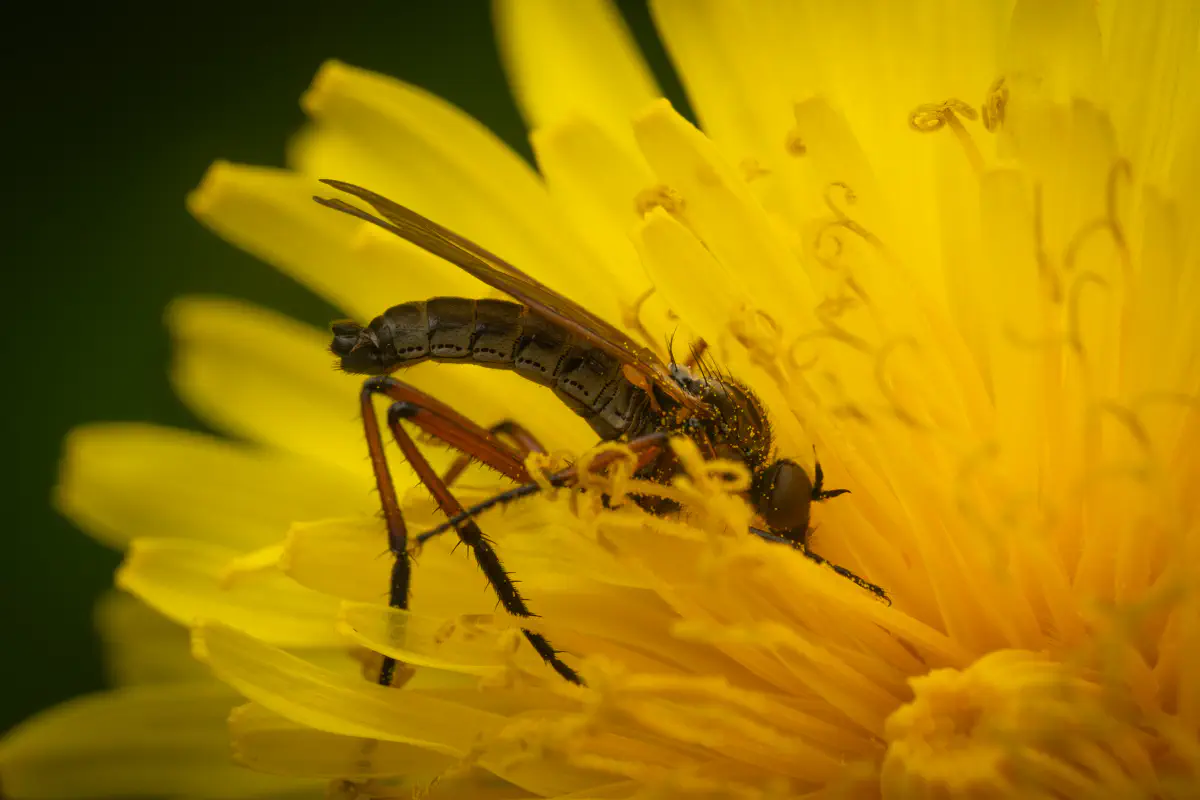

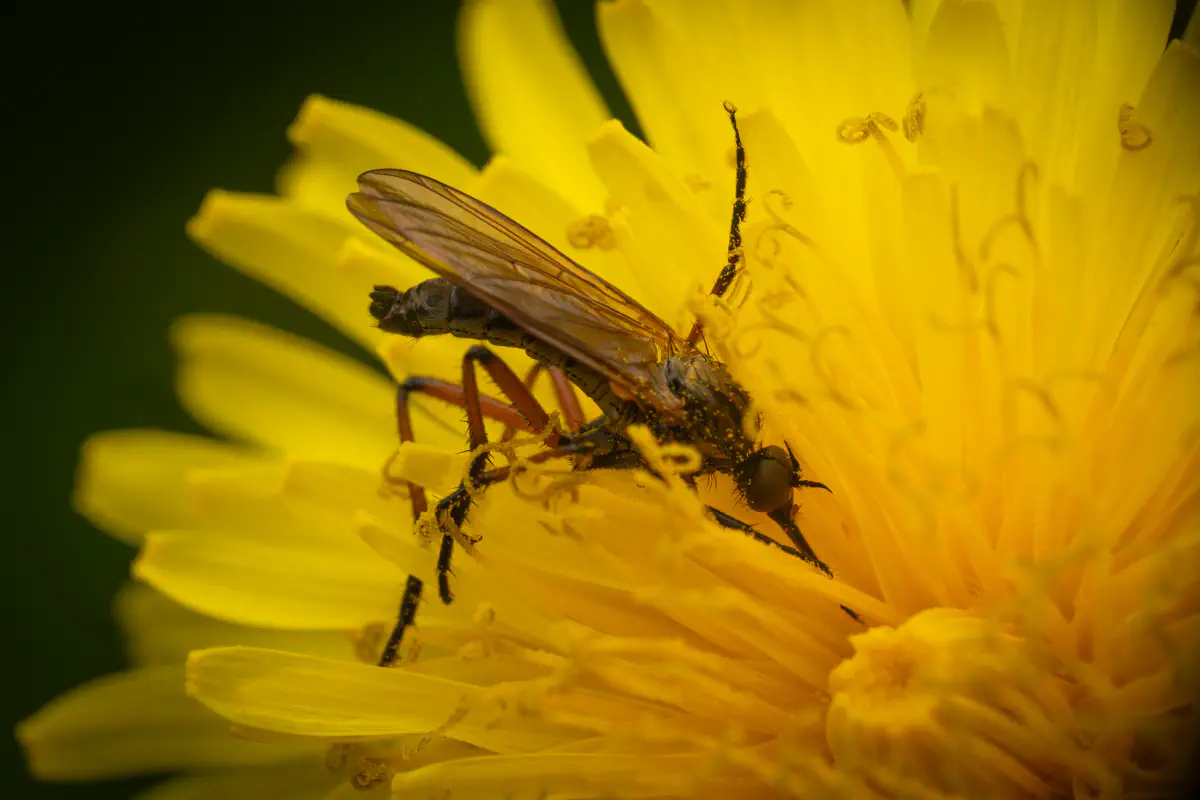
Ancestry Graph
Further Information
„Dance Flies“ on wikipedia.org
„Dance Flies“ on iNaturalist.org
Copyright

This article uses material from the Wikipedia article Empididae the free encyclopedia Wikipedia which is released under Creative Commons Attribution-ShareAlike 4.0 International License). On Wikipedia a list of authors is available.

Little beings in print
Order our calendars and books today!
Compiled with love. Printed sustainably. Experience our little beings even more vividly in print. All our publications are available for a small donation.
